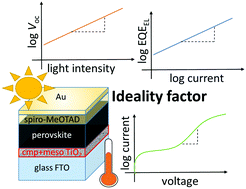当前位置:
X-MOL 学术
›
Energy Environ. Sci.
›
论文详情
Our official English website, www.x-mol.net, welcomes your feedback! (Note: you will need to create a separate account there.)
Interpretation and evolution of open-circuit voltage, recombination, ideality factor and subgap defect states during reversible light-soaking and irreversible degradation of perovskite solar cells
Energy & Environmental Science ( IF 32.5 ) Pub Date : 2017-11-02 00:00:00 , DOI: 10.1039/c7ee02415k Wolfgang Tress 1, 2, 3, 4, 5 , Mozhgan Yavari 4, 5, 6 , Konrad Domanski 1, 2, 3, 4, 5 , Pankaj Yadav 1, 2, 3, 4, 5 , Bjoern Niesen 3, 5, 7, 8, 9 , Juan Pablo Correa Baena 10, 11, 12 , Anders Hagfeldt 4, 5, 6 , Michael Graetzel 1, 2, 3, 4, 5
Energy & Environmental Science ( IF 32.5 ) Pub Date : 2017-11-02 00:00:00 , DOI: 10.1039/c7ee02415k Wolfgang Tress 1, 2, 3, 4, 5 , Mozhgan Yavari 4, 5, 6 , Konrad Domanski 1, 2, 3, 4, 5 , Pankaj Yadav 1, 2, 3, 4, 5 , Bjoern Niesen 3, 5, 7, 8, 9 , Juan Pablo Correa Baena 10, 11, 12 , Anders Hagfeldt 4, 5, 6 , Michael Graetzel 1, 2, 3, 4, 5
Affiliation

|
Metal halide perovskite absorber materials are about to emerge as a high-efficiency photovoltaic technology. At the same time, they are suitable for high-throughput manufacturing characterized by a low energy input and abundant low-cost materials. However, a further optimization of their efficiency, stability and reliability demands a more detailed optoelectronic characterization and understanding of losses including their evolution with time. In this work, we analyze perovskite solar cells with different architectures (planar, mesoporous, HTL-free), employing temperature dependent measurements (current–voltage, light intensity, electroluminescence) of the ideality factor to identify dominating recombination processes that limit the open-circuit voltage (Voc). We find that in thoroughly-optimized, high-Voc (≈1.2 V) devices recombination prevails through defects in the perovskite. On the other hand, irreversible degradation at elevated temperature is caused by the introduction of broad tail states originating from an external source (e.g. metal electrode). Light-soaking is another effect decreasing performance, though reversibly. Based on FTPS measurements, this degradation is attributed to the generation of surface defects becoming a new source of non-radiative recombination. We conclude that improving long-term stability needs to focus on adjacent layers, whereas a further optimization of efficiency of top-performing devices requires understanding of the defect physics of the nanocrystalline perovskite absorber. Finally, our work provides guidelines for the design of further dedicated studies to correctly interpret the diode ideality factor and decrease recombination losses.
中文翻译:

钙钛矿型太阳能电池的可逆吸光和不可逆降解过程中开路电压,复合,理想因子和亚隙缺陷状态的解释和演化
金属卤化物钙钛矿吸收材料即将成为一种高效的光伏技术。同时,它们适用于以低能量输入和丰富的低成本材料为特征的高产量制造。但是,要进一步优化其效率,稳定性和可靠性,就需要更详细的光电特性和对损耗的理解,包括损耗随时间的变化。在这项工作中,我们采用理想因子的温度依赖性测量(电流-电压,光强度,电致发光)来分析具有不同结构(平面,中孔,无HTL)的钙钛矿太阳能电池,以识别限制开放式结构的主要复合过程。电路电压(V oc)。我们发现,在经过彻底优化的高V oc(≈1.2V)器件中,钙钛矿中的缺陷会导致重组。另一方面,高温引起的不可逆降解是由于引入源自外部来源的宽尾态(例如金属电极)。透光是降低性能的另一种效果,尽管这种效果是可逆的。基于FTPS测量,这种退化归因于表面缺陷的产生,这些表面缺陷成为非辐射复合的新来源。我们得出的结论是,提高长期稳定性需要着眼于相邻层,而进一步优化顶级性能器件的效率则需要了解纳米晶钙钛矿吸收剂的缺陷物理。最后,我们的工作为进一步专门研究的设计提供了指导,以正确解释二极管的理想因数并减少重组损失。
更新日期:2017-11-08
中文翻译:

钙钛矿型太阳能电池的可逆吸光和不可逆降解过程中开路电压,复合,理想因子和亚隙缺陷状态的解释和演化
金属卤化物钙钛矿吸收材料即将成为一种高效的光伏技术。同时,它们适用于以低能量输入和丰富的低成本材料为特征的高产量制造。但是,要进一步优化其效率,稳定性和可靠性,就需要更详细的光电特性和对损耗的理解,包括损耗随时间的变化。在这项工作中,我们采用理想因子的温度依赖性测量(电流-电压,光强度,电致发光)来分析具有不同结构(平面,中孔,无HTL)的钙钛矿太阳能电池,以识别限制开放式结构的主要复合过程。电路电压(V oc)。我们发现,在经过彻底优化的高V oc(≈1.2V)器件中,钙钛矿中的缺陷会导致重组。另一方面,高温引起的不可逆降解是由于引入源自外部来源的宽尾态(例如金属电极)。透光是降低性能的另一种效果,尽管这种效果是可逆的。基于FTPS测量,这种退化归因于表面缺陷的产生,这些表面缺陷成为非辐射复合的新来源。我们得出的结论是,提高长期稳定性需要着眼于相邻层,而进一步优化顶级性能器件的效率则需要了解纳米晶钙钛矿吸收剂的缺陷物理。最后,我们的工作为进一步专门研究的设计提供了指导,以正确解释二极管的理想因数并减少重组损失。



























 京公网安备 11010802027423号
京公网安备 11010802027423号